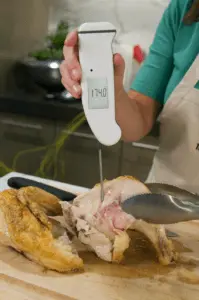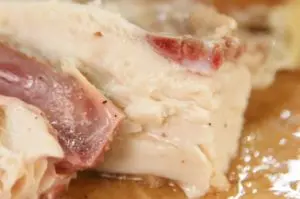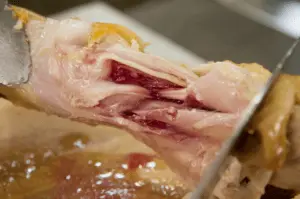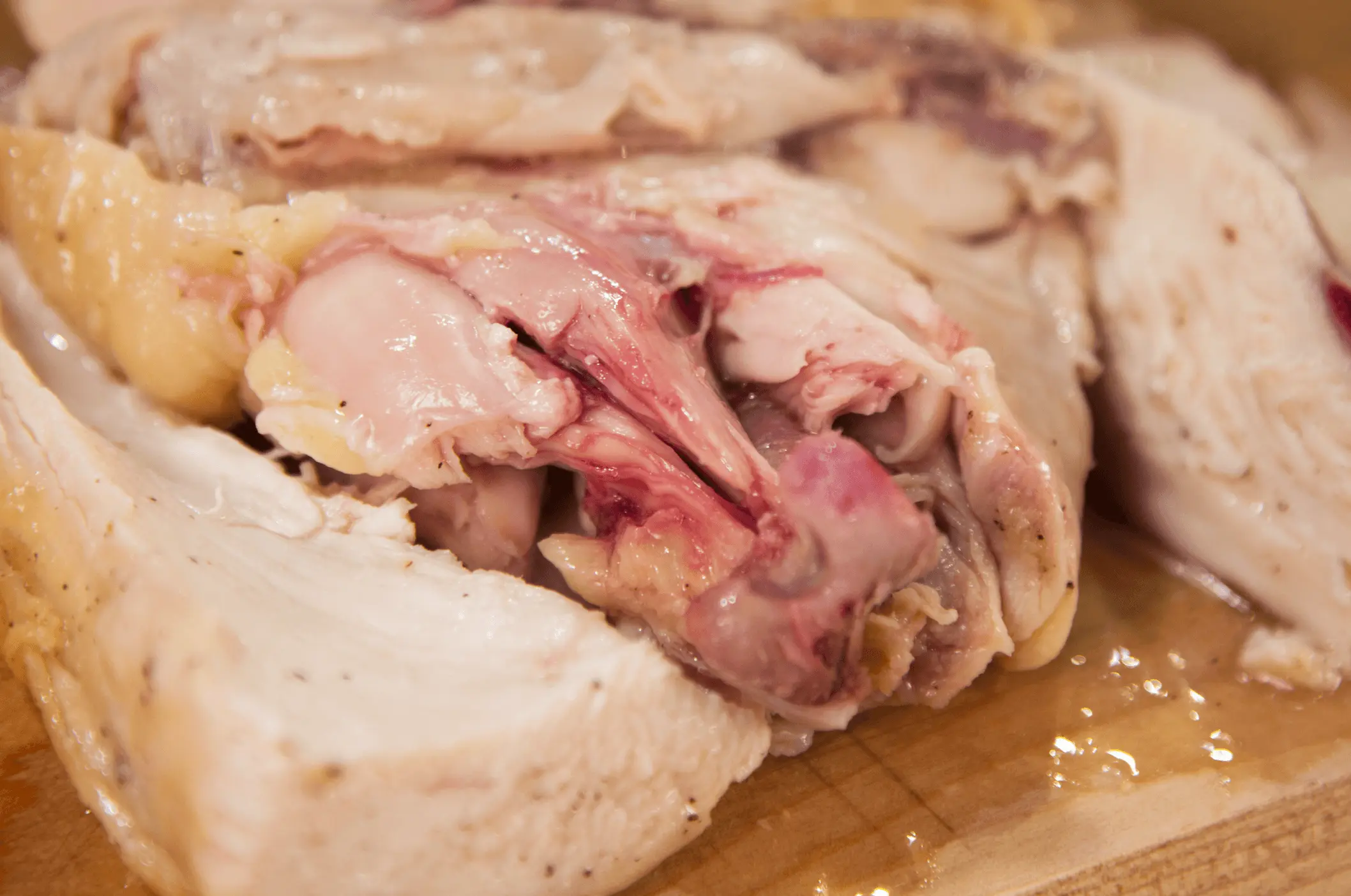Safe Chicken Temperatures, Even if It’s Pink!
Knowing the proper doneness temperatures when cooking chicken will ensure juicy results. But what if the meat or juices are pink, and it looks bloody? If you’re like many, the sight of anything but perfectly opaque meat with clear juices can make you cringe when chicken is on the menu.
Keep reading to find out what actually causes this the pink color in chicken and how to be sure your family’s chicken temperature is truly safe.
Chicken Doneness is a Temperature, Not a Color
Chicken meat cooks to a creamy-white color—unlike the more robust hues of cooked beef, pork, or lamb. This white color provides a much starker contrast to the occasional pink tones that can naturally occur in any meat.
Dr. O. Peter Snyder, Jr., Ph.D. of the Hospitality Institute of Technology and Management says, “If consumers were taught to eat safely prepared, bloody chicken, as they want to do with beef, they would be able to enjoy juicier chicken.” The trick is to learn how to prepare safe-to-eat chicken and get over our fear of a little blood in our birds.
So, how do you know for sure if your chicken is safe to eat? One word: temperature.
Overcorrecting with Overcooking
Perhaps one reason society accepts red and pink hues in steaks is that beef can be safely cooked to varying degrees of doneness. Chicken, on the other hand, is either safe to eat or it’s not. There is no such thing as medium-rare chicken. Nevertheless, too many cooks overcook their chicken temperature for fear of undercooking it. Overcooked chicken is just like overcooked beef: dry, tough, and less flavorful than properly-cooked meat
Regardless of the type of meat being cooked, the higher the doneness temperature, the more juices will be lost and the less tender the results will be. Properly gauging the internal temperature of chicken is the only way to guarantee safe and juicy results every single time.
Internal Temperatures for Doneness and Eating Quality of Chicken
➤ 165°F
What is so magical about 165°F (74°C)? At 165°F (74°C) all foodborne bacteria instantly die This instant death for foodborne pathogens is recommended for poultry because even the most stubborn salmonella bacteria will be completely pasteurized at this temperature. Even if a slow, low-accuracy dial thermometer is off by as much as 10°F (6°C), a final cooked temperature of 155°F (68°C) in chicken will only need to stay at that temperature for just under 60 seconds in order for the meat to be safe. (Does that sound like it goes against everything you’ve ever learned about chicken safety? If so, you might need to read our complete guide to chicken temps to brush up on the nuances of bacterial kill times.)
➤ 170°F and Higher for Dark Meat
Leg and thigh meat is still safe at 165°F, but it is recommended to cook it to an internal temperature of about 170-175°F (77-79°C). The chicken’s legs are actively worked muscles, and the meat is tougher because of it.

The leg pictured to the right was cooked to the recommended range of 170-175°F (77-79°C) (as verified with a Thermapen® ONE). Leg meat needs to be cooked to higher temperatures than the leaner and more delicate breast meat because it contains more connective tissue that needs time at high temps to dissolve properly. This higher temperature will ensure that the dark meat becomes tender and juicy. Even at this higher temperature, the meat still appeared quite pink.
Common Myth: “Chicken is Done When the Juices Run Clear”
One common but inaccurate method of verifying the doneness of chicken is to cut into the meat and watch to be sure all of the juices are running clear. When probing chicken over the grill or in the oven, we sometimes look for anything pink in the meat as a clear indication that its not yet properly cooked. The fact of the matter is that depending upon where you probe your chicken, the color of the meat or juices may never be free of pink, red, or even purple tones.
So why does chicken so often appear undercooked?
Why Cooked Chicken Can Still Be Pink
Reason 1: Young Chickens

The chickens available at grocery stores that we purchase are usually between 6 and 8 weeks of age. These young chickens aren’t yet fully mature, and their bones are porous rather than completely calcified. The bone marrow inside of chicken bones is purplish and can often permeate through soft, porous chicken bones (pictured at right).
The liquid contained in the mass of a chicken expands during freezing, including the bone marrow. The dark marrow can push through the bone’s surface as it expands. The bones and meat adjacent to them become stained, and will remain a deep red/purple color regardless of the final internal temperature of cooked chicken.
Reason 2: Myoglobin

Myoglobin is another culprit for the purple and red colors found in poultry. It is a richly pigmented protein that delivers oxygen to cells to muscle fibers. The more active an animal is, the more oxygen is contained in their muscle, giving it a darker color.
Chickens are flightless birds, so the breast meat is never heavily oxygenated. Low levels of myoglobin are why chicken breasts have such delicate white flesh. The heavily worked legs have darker meat because of higher levels of myoglobin.
While chicken is packaged and readied for purchase in a grocery store, myoglobin can tend to pool in the meat fibers.
Reason 3: pH Levels
The acidity of the meat can affect its color, too. The higher the pH level (lower acidity), the pinker the meat will be. This is why some chefs use an acidic marinade with citrus or vinegar to help reduce pink colors in chicken meat. But marinades will do little to protect against tinges of pink from marrow and myoglobin.
Eat Pink Chicken Confidently
Now that you know why your chicken can sometimes be pink, it’s time to eat chicken more confidently. Most importantly, stop overcooking your chicken!
Armed with an accurate thermometer like the Thermapen, you can verify the safety and quality of your chicken—regardless of its color. A probe inserted into the thermal center of a chicken breast, leg, or thigh should read 165°F (74°C) when it’s time to eat.
(Thanks to AmazingRibs.com for the inspiration for this article.)
Shop now for products used in this post:




While most of this article is good there are many thermophilic bacteria that can withstand temperatures at or above 165F (even as high as 220F), but NONE of these bacteria are known to cause disease, nor would they ever be found on a chicken or in a kitchen.
How funny – I JUST had this happen tonight with some HUGE bone-in breasts that I baked, but I knew I was good to eat it because I did check with my Thermapen and got a reading of 167!
From Alan Bowman via Facebook: Interesting. As a competition judge, we are taught to automatically disqualify any entry that contains any trace of blood…and I’m OK with that.
There’s no blood. The red you see is myoglobin and after reading this article you should advocate to change the competition rules.
Maybe at home when you check the temp but in restaurants you don’t know that they didn’t go by the look to judge that it is done. I worked as a correctional officer supervisor in a prison kitchen and we cooked large quantities of chicken leg quarters (fried and baked). I would check numerous pieces for temperature in each batch for a temperature of at least 180 to 200 degrees. Putting any pink chicken out the serving window could have led to a riot.
Ya but that’s cause for mass serving food, the guidelines for safe are way higher than necessary simply because a mistake will cause more people to be sick.
By standard food science and bacteriology, you could have safe chicken well below 165. If you hold chicken at 150 for 3 minutes, then you’d achieve the same effect. The 165 temp is specifically only the temperature which most relevant bacteria will be killed instantly. But there’s nothing in science that says bacteria that is killed in 3 minutes is more dangerous. The USDA itself even says you can cook chicken to 140 degrees as long as you hold it at 140 for at least 28 minutes.
That’s why no one that likes steak actually cooks steak to the 145 guideline. You’re already 20+ degrees over med rare.
Thanks for the data on Is bloody chicken an indication that it’s been undercooked? | ThermoWorks.com, it will likely be genuinely helpful.
It’s funny how we will eat raw fish, or rare beef, but cringe at bloody chicken.
Thank you for the update. You changed my mind (but probably not my guests).
John,
It’s an interesting topic for sure. Read through our post, Thermal Tips: Simple Roasted Chicken for more information on poultry pasteurization temps. Everyone should be able to prepare chicken without overcooking it “just to be safe.”
Thank you for your comment,
-Kim
QUESTION: Does altitude affect the temperature for properly cooked chicken (or other meats)?
Alison,
Great question! There is lower air pressure at higher altitude, and because of that water doesn’t have as much pressure to overcome in the boiling process. The most profound effects of high altitude are with boiling points and landmark temperatures for sugar cooking stages. Read through our article, High Altitude and Its Effects on Cooking. With all the havoc high altitude can wreak in the kitchen, it does not affect doneness temperatures with meat. No need to worry about adjusting temperatures there.
Thank you for your question!
-Kim
So which temperature is it? First it said the magic number is 165 and all food born pathogens would be instantly killed, but then it said to cook the leg until 175.
De,
There are two different major landmarks with cooking chicken and turkey: 165°F and 175°F. 165°F is the temperature the food should be cook to for food safety. The higher temperature for the legs is for eating quality purposes, not food safety. The legs are more actively worked muscles of the animal, the meat is tougher and contains connective tissues that need higher temperatures in order to properly dissolve. The leg meat is safe to eat at 165°F, but for tender and juicy leg meat it is recommended to cook it to higher temperatures.
Thank you for your comment,
-Kim
Could bacteria such as salmonella continue to survive in the marrow of chicken cooked to an internal temperature of 165°F, and then leak out of the bones into the meat?
Eliat,
Great question! As long as the bones and marrow reach a safe pasteurization temperature, there isn’t any reason to worry about pathogens from the marrow leaching into the meat.
I looked around for some information on the level of pathogens contained in chicken bone marrow since most pathogens live on the surface of the skin and meat. According to this dissertation on the the level of salmonella in the carcass bone marrow and neck skin of a broiler chicken at the University of Georgia, salmonella prevalence in the bone marrow was only 0.8%, while the level in the neck skin was 21.4%.
The level of salmonella in the marrow is very negligible in comparison to the rest of the bird. As long as your temperatures are held at pasteurization levels for the appropriate amount of time, there isn’t any reason to worry about pathogens contaminating the meat from absorbed marrow.
Thank you for your question!
-Kim
Ray,
So glad to hear the Thermapen has been so helpful in improving your family meals! Understanding how temperature affects food, and using professional temperature tools is really a game-changer. Hopefully this info will have you confidently preparing juicy chicken!
Thanks for your comment,
-Kim
That is both very sad and hysterical! I’m happy you’re finally eating juicy meat!
This is great info. Most people are so skittish when it comes to chicken but will eat beef tartare, poke, and sashimi and those are all raw! They’ll also eat fries and veggies raw even though they can harbor salmonella.
Interestingly, there’s a sushi restaurant in Japan that actually serves raw chicken! Not that I’m recommending it but it goes to show that you don’t automatically get sick from chicken that’s raw, undercooked, or properly cooked and still pink.
Correction for you city folks: Chickens are not flightless birds. We clip the wings so they don’t fly all over the place.
Charcoal grilled chicken is a staple in our household and has been for many, many years (I am 80). Bone-in, skin on chicken breast comes off the grill between 153-155 degrees and thigh/leg at 175. It goes right to a cutting board, covered with tin foil and sits for no less than 10 minutes. We get perfectly cooked, juicy chicken every time and have never had a problem
Read The Food Lab book by kenji lopez. Tells you its not just temp. Its time and temp. I cook all my chicken to 155 deg and hold it at that temp for 60 seconds and its so juicy and flavorful and safe to eat.
Please post the suggested PULL temperatures for thighs vs legs vs breasts. Thank you, Carol
For breasts, we usually pull at 157°F, for thighs, we don’t pull until after 175°F because of the extra connective tissue.
So–do I consider ‘residual’ cooking /heat when cooking a chicken breast? (ie: pull at 160F knowing it will rise when it wrap and rest?
thanks!
Yes! It will carry over, coming up to a higher temp, AND it may even be safer at a lower temperature. Read more at our blog post about chicken internal temperatures.
ThermoWorks, I love your products and blog. But it seems that this old article has been outdated by your newer posts which advise temperatures of 157 for chicken and 155 for turkey. Why did I just receive an email from you with this old post?
Thanks for great products.
The main thrust of this post is supposed to be that it may not look done, even though it is safe. yes, you can cook to lower temperatures, and we have a great post about that!